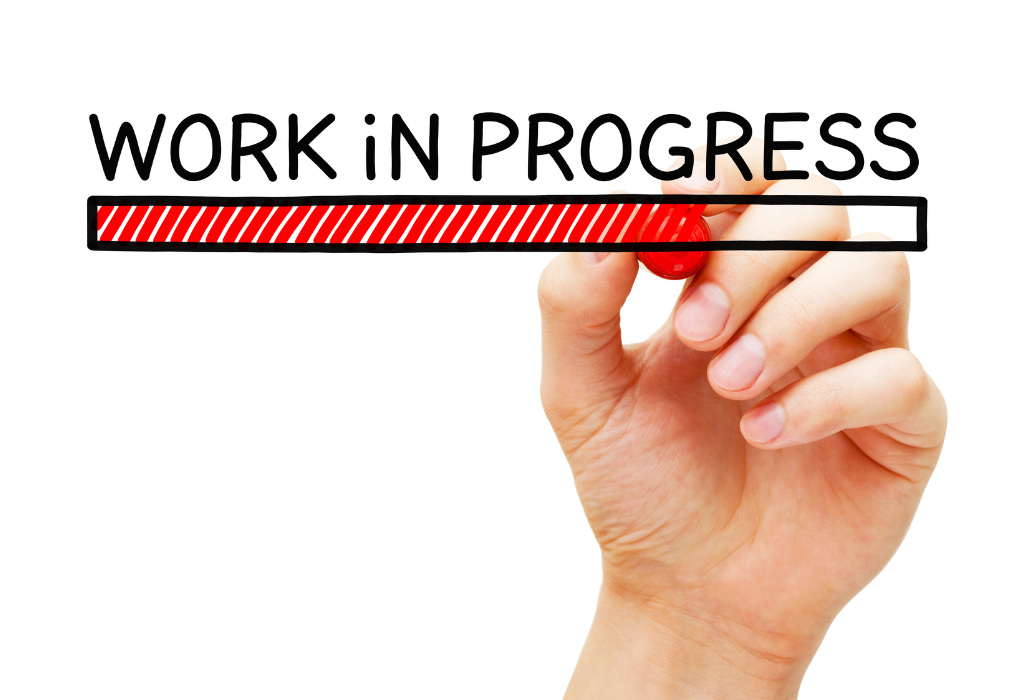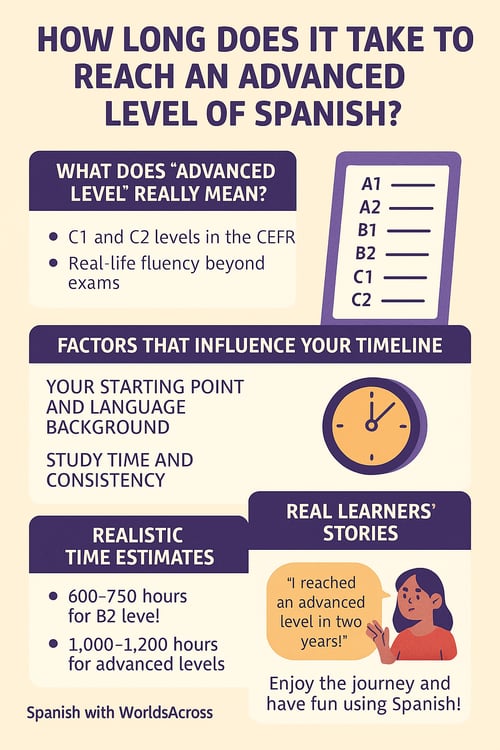How long does it take to reach advanced level in Spanish?
There’s one question that every Spanish student asks. No, it’s not “What even is the subjunctive?!” Even though that’s also extremely common.
The million-dollar question is this: “How long does it take to reach an advanced level in Spanish?”
Firstly, it’s a perfectly valid question. It’s natural to be curious and hope for a clear deadline for when you’ll be able to say, “I did it! I speak Spanish.”
Behind that question, though, there’s more. There’s a whole history with different learning methods, frustrations, obstacles, and unrealistic timelines.
Here, you have a chance to learn what Spanish proficiency really means, how long it takes to get there, and what factors make a difference. Are you ready?

What Does “Advanced Level In Spanish” Really Mean?
Every student wants to reach this goal. The most-wanted advanced level. But have you ever stopped to think about what exactly it means?
This is an essential first step in your journey. You need to be clear in your goal so you can actually learn Spanish in the right direction. This is how you figure out the things you need to do to get there.
The most interesting part about this question is that it’s not so simple. There’s not just one answer. Let’s see why that is.
The “Official” Framework
If we stick to “official” sources, we have to talk about CEFR (Common European Framework of Reference). This is the standard scale in which Spanish fluency is measured. Here is a broad look at the main categories:
- A1 - Breakthrough
- A2 - Waystage
- B1 - Threshold
- B2 - Vantage
- C1 - Advanced
- C2 - Mastery
In this context, C1 and C2 are the levels officially considered to be advanced.
Now, you might wonder, “Well, how exactly does one get there? How do you even know when you reach those levels?”
Again, in this technical context, the answer would be a test like the DELE. That’s a standardized test that evaluates a student's Spanish proficiency. The results will assign you one of the levels from A1 to C2.
Here’s where it gets extra interesting, though. Is this the only way to measure your Spanish fluency? No, not at all.
There’s more to it, and we’re going to talk about it next.
Spanish Proficiency Beyond Exams
When you decide to learn Spanish, you don’t do it to pass a test, do you?
People learn a language to connect with other people: friends, family, neighbors, coworkers, and people from all over the world who speak Spanish.
This means that your language progress doesn’t depend exclusively on how well you follow grammar rules. It’s even more important to use the language.
You can notice real fluency in factors like this:
- Communicating effectively with others (even if you make mistakes).
- Understanding native speakers and casual conversations.
- Speaking Spanish with confidence (instead of aiming for perfectionism).
- Cultural awareness of the language and social interaction.
You see? Passing a test isn’t the only way to reach an advanced level in Spanish.
If you can understand the language and have real conversations in Spanish, that’s real-life fluency! You can get there!
Now you know the goal you have to aim for, but that’s not all you need before you can set a deadline for Spanish proficiency. There are a few more factors that will affect your language journey. Let’s take a look at them!
Factors That Influence Your Timeline
The most important thing you should know in this journey toward your goal of fluent Spanish is that every journey is unique. It’s hard to determine an official timeline because everyone’s circumstances are different.
So, to plan your study time and how long it’ll take to speak Spanish, these are some of the things you should take into consideration.
Your Starting Point And Language Background
Not everyone starts to learn Spanish from zero.
If you have some background, it can help a lot. That means everything from growing up listening to family members speak Spanish to taking Spanish classes in school or college.
It’s not just that either. If you’ve already learned a different language before, learning Spanish might be a little easier for you.
If you speak a language like Italian or Portuguese, Spanish will also seem easier, because they are a little similar.
These are a few advantages that some people have at the moment of starting this journey. But, at the end of the day, it takes time and effort for everyone! Most importantly, everyone can learn.
Study Time And Consistency
Think of this as simple math to add to your study time.
If you practice Spanish one hour every day, you will reach your goal faster than if you only practice one hour every week.
However, it’s also important to consider the quality of this time. If you use effective methods, you’re on the right track. But if you’re stuck with outdated strategies that don’t work for you, you could be wasting your time.
If you can combine a consistent schedule with good learning methods, you can reduce the time it takes to learn the language.
The Best Learning Methods
Now you know how important it is to choose good learning methods for your study time. It’s time to ask, “Well, what exactly are those methods?”
Again, this will depend a lot on each different student. Different methods will work for different people. The key is finding out what works best for you.
In general, you should aim to combine receiving comprehensible input, producing output, and actively engaging with the language.
That means focus on immersing yourself in the language, but don’t forget about participating in real-life conversations.
Then you’ll be on the right path toward Spanish fluency!
Realistic Time Estimates
It’s time to face concrete data to determine how long it takes to reach an advanced level in Spanish.
As you consider these estimates, don’t forget that the results vary a lot depending on the factors we mentioned. Remember that your journey is unique and that your background and your methods will affect language progress.

Official Data
Let’s look at the numbers from the Foreign Service Institute (FSI) and the generally accepted timeline.
- 600–750 hours for B2 level.
- 1,000–1,200 hours for advanced levels.
Again, even though these numbers depend on different factors, this is a useful guide.
With an average of 1,000-1,200 hours to reach an advanced level, you can plan accordingly. Set realistic goals. Organize your study time with that goal in mind.
For example, we can turn it into months or years. Always keep in mind that this is just an approximation, and you might miss some days of practice here and there:
- Practicing one hour daily: It could take about three years.
- If you practice two or three hours daily: It could go down to approximately one year.
With that average count, it’s up to you to find out how it works for you specifically!
Real Learners’ Stories
Let’s take a moment to highlight just how different everyone’s journeys can be. These are some WorldsAcross students who have shared their stories and their Spanish language progress.
- One student started out doing only 15 minutes of comprehensible input a day. After starting to have real conversations in Spanish classes, he reached an advanced level in Spanish in two years.
- There’s another student who spent his first two years learning only with comprehensible input. He completed 1,000 hours of input in Spanish! Now, after starting to use the language, he speaks fluently and confidently!
- Here’s another case of a student who got 1,000 hours of comprehensible input before starting to speak. But after a year of Spanish classes, he communicates effectively in Spanish!
Isn’t that inspiring?
Remember: there’s not one answer that fits every Spanish learner. Your Spanish progress is unique, and you should measure it by your own standards.
Do you want to know the best part about reaching an advanced level in Spanish?
The journey is meant to be enjoyed! Have fun with it, experiment with different learning methods, and don’t forget to go out there and use everything you’ve learned. You got this!


